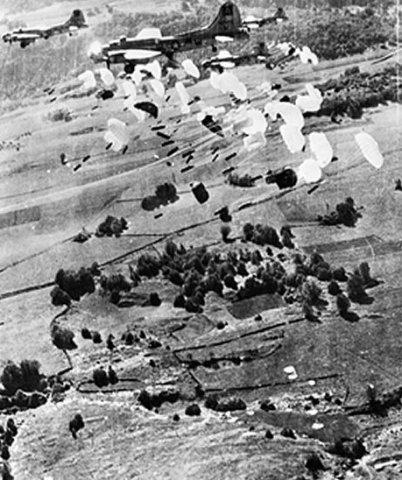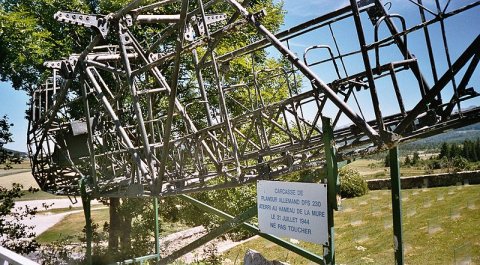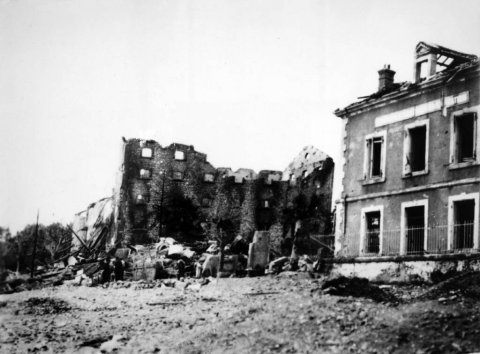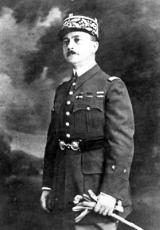Le Vercors

In 1940, Le Vercors, a genuine natural fortress, sixty kilometres long and 30 wide, at an altitude of over 2,340 m between L'Isère and La Drôme, was a place of refuge especially for victims of the Vichy Government's political and racial discrimination measures.
With the occupation of the southern zone in November 1942, the Vercors mountain also became the site of resistance for those who rejected the idea of a subservient France. Those who refused STO i.e. the compulsory working service that sent young French to work in Germany, swelled the ranks of the maquis.

Young maquisards. Source: Departmental archives of Le Drôme
But these maquisards were lacking a plan, a strategy. In fact, as early as 1942, Pierre Dalloz and his friend the writer Jean Prévost had the idea of transforming the massif into a ”Trojan horse for airborne commandos”. This idea took shape in January 1943: Le Vercors would intervene during the expected allies landings in Provence and the airborne troops would immediately take the battle to the rear of the enemy.
The project, accepted by Jean Moulin and general Delestraint, Commander of the Secret Army, became the ”Mountaineers plan”. It was approved by general de Gaulle and the Allies in London and Algiers. This plan was implemented by Alain Le Ray then François Huet, military leaders of Le Vercors in association with Eugène Chavant, civilian chief of the maquis. It seems clear that the constitution of this maquis and its placing on alert was not to take place until the summer of 1944 after the landing in the South.
By 1943, the resistance was getting organized in the mountains. A dozen camps had been set up in the heart of the forests. By early 1944, they comprised 400 to 500 civilians and combat personnel, some very young, with food being provided by a generally favourable population and weapons and medicine from allied airdrops.

USAAF B-17 dropping materiel for the maquis. Source: USSTAF photographer.
June 6, 1944, Le Vercors answers the general mobilisation order. On 25 and 28 June, numerous airdrops helped arm the resistance fighters. In early July, 4,000 volunteers proclaimed the 'Vercors Republic' and flew the French Tricolour over a territory declared to be 'free.' These revolting mountaineers were a challenge to the enemy. In Grenoble, the German general Pflaum decided to eradicate them. The 'Mountaineers plan' was not applied. The maquisards, potential attackers, were now under siege.
Throughout June, the Germans lead several offensives intended to test the effective resistance of the maquis: on June 13 and 15 against the village of Saint-Nizier which was burned and on June 17 and 24 in the Défilé des Ecouges.
Rail traffic was disrupted, ambushes organised, allied missions were parachuted in and containers dropped. The maquisards cleared sites to receive the planes they expected to land. In valley villages, captured resistance fighters were shot.
On 14 July, a drop of containers above Vassieux was followed by a German bombing operation that destroyed the village. Messages requesting air intervention and ammunition continued to be sent to Algiers.
The Germans decided to go all out: four battalions of the 157th alpine division of the Wehrmacht, two mountain artillery batteries, three battalions of auxiliaries recruited among Soviet prisoners, 200 Feldgendarmerie men, part of a security regiment — all supported by an air squadron.
On 19 July, the enemy took up position at Saint-Nizier and Paillasse then attached the Col de Grimone. The next day, they attacked Crest and Saint Nazaire-en-Royans, completing the encirclement of Le Vercors.
On July 21, 1944, after a few offensives intended to test the effective resistance of the maquis, in particular in Saint-Nizier, on 13 and 15 June, 1944, and Les Ecouges, on 21 June, Pflaum sent in 15,000 troops taken from the Normandy front to attack Le Vercors. The attack was an across the board attack, by road, over the steep passes that can only be crossed on foot, and by air in Vassieux the Waffen SS gliders landed there where it was expected the Allies would: 200 SS disembarked while 300 others were parachuted in. By the evening, the enemy held the village; 11 villagers were shot and 101 resistance fighters killed. The Germans reached Châtillon-en-Diois and Le Pas de l'Aiguille in the south, Villard-de-Lans and Autrans in the north and Saint-Jean-de-Royans in the west.
On the 22rd the German advance which the maquisards tried to counter by manoeuvring, continued slowly. The Pas de la Balme and Pionnier pass were occupied. Die was taken.
On the 23rd, the resistance counter-attacked at Vassieux but had to fall back while German reinforcements were brought in to the plateau. The fighting intensified. A maquis company was annihilated at Valechevriere. The Pas sector eventually gave way. Resistant units begin to disperse into the forests.
On the 24th, the Germans were at the Rousset pass at Pré-Grandu. The wounded but valid maquisards evacuated the Luire cave which had been transformed into a hospital. The Allies bombed the Chabeuil airfield.
On the 25th, the different German detachments joined up. Chapelle-en-Vercors was raided and 16 hostages executed. The last resistance fighters reached La Mure, Vezon.
On the 26th, numerous young recruits, falling back from Saint-André-de-Royans towards the plain fell into the hands of the enemy. In Petits-Goulet, 104 maquisards managed to escape the German beats.
On the 27th, the maquisards in the southern zone of the plateau fell back while inflicting heavy losses on the enemy. Elements from the 157th German ID took hold of the Luire cave where they killed off the seriously wounded. The repression intensified on the plateau.
On the 28th, the maquisards stopped an enemy column from advancing towards Limouches pass, but a fresh German attempt the next day succeeded. The village of Léoncel was pillaged.
In the South Drôme sector, sharp clashes continued.

Valchevriere Chapel, Isère, France. Source: Photo Eric Lapeyre
After a week of hard but unequal fighting, the Vercors was on its knees. More than 600 resistance fighters and one hundred Germans were killed.

Makeshift cemetery in Vassieux en Vercors. Source: Departmental archives of Le Drôme
The civilian population exposed to the savagery of the attackers paid a heavy tribute: 201 people died in often atrocious conditions, 41 others were deported and 573 homes were destroyed.

Ruin in Vassieux: More abandoned that betrayed, Le Vercors was to become a place of remembrance as a result of these dramatic events, embodying resistance, freedom but also tragic heroism.
Source: Departmental archives of Le Drôme




